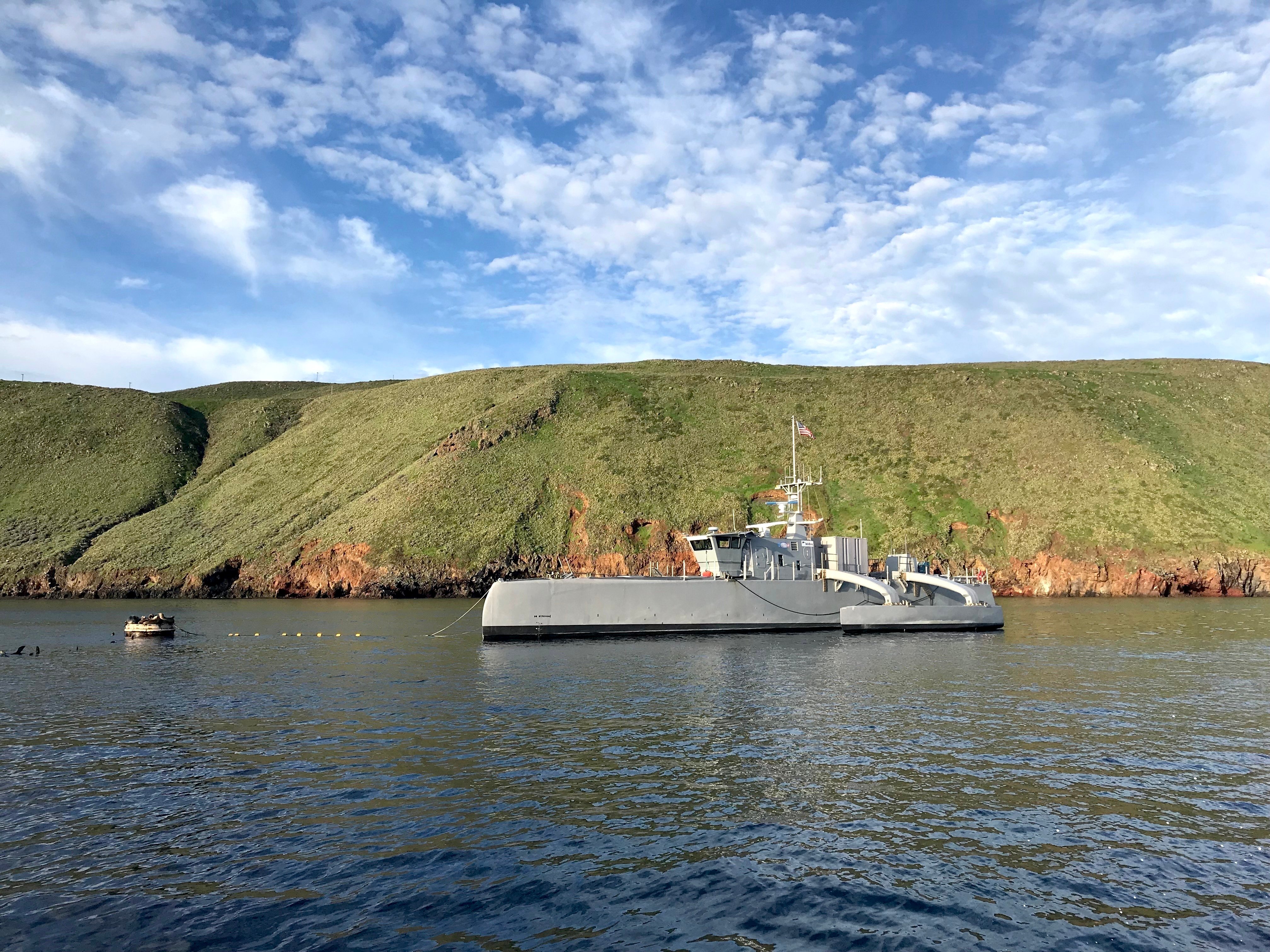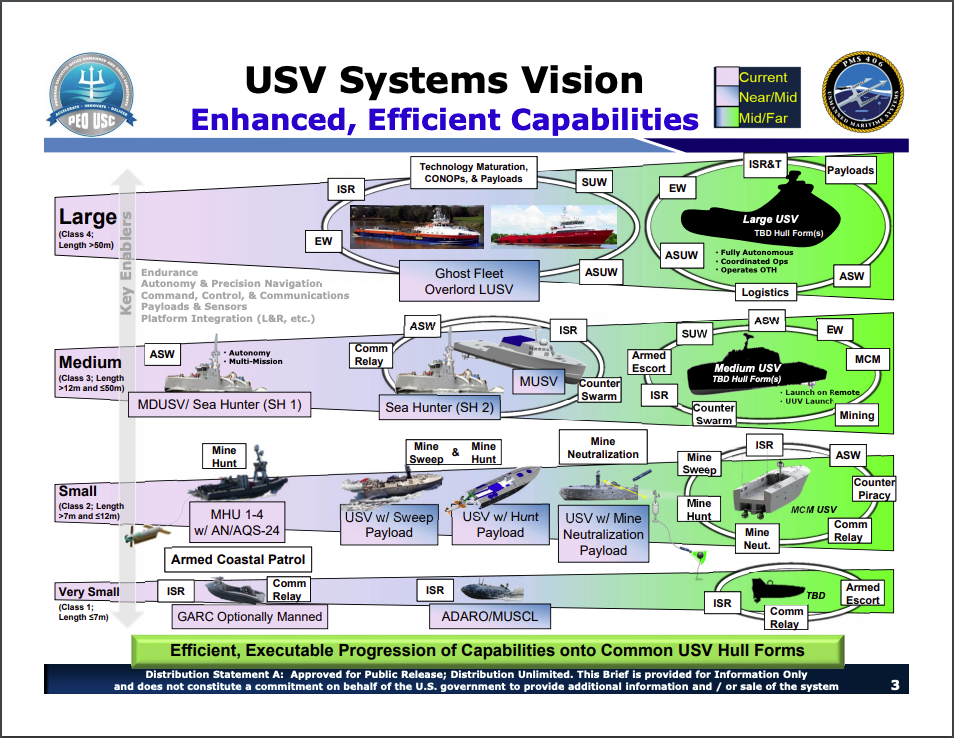
The Navy has awarded a contract for the first unmanned surface vessel it will design and build on its own, a key milestone for the eventual family of unmanned systems that will be a key component of the future surface fleet, according to a Monday contract announcement from the Pentagon.
L3 Technologies won a $35-million contract to develop a prototype medium unmanned surface vehicle (MUSV) on Monday, which could grow to $281 million if options for eight follow-on craft are exercised, Naval Sea Systems Command announced.
The contract calls for delivering the first prototype by the end of the Fiscal Year 2023, according to a release from NAVSEA.
“The president’s 2021 budget request for the Navy includes additional funding for a second MUSV prototype in FY23. The acquisition strategy for the FY23 vessel is to be determined, however, for flexibility, the development contract contains options for additional USVs,” read the statement.
The award to L3 for MUSV is the Navy’s first bite at the apple for developing a USV. DARPA contracted for two Sea Hunter vessels in what was originally the Anti-Submarine Warfare (ASW) Continuous Trail Unmanned Vessel (ACTUV) program but has since shifted its focus to be the predecessor to MUSV. A Pentagon office also contracted for two Large USVs as part of the Overlord program, and the Navy will also take those vessels and use them to shape an eventual LUSV program of its own.
The Navy envisions a family of unmanned systems that will be the backbone of a future fleet of netted “attritable” platforms that will provide lower-cost options compared to manned surface combatants like the Arleigh Burke-class destroyer or the new FFG(X) frigate program.
“The initial focus is on the design, fabrication, testing and support of funded MUSV prototype vehicles. Rapid prototyping efforts will inform procurement of additional MUSV units,” Navy spokesman Capt. Danny Hernandez told USNI News on Tuesday.
“The Navy will continue to assess the MUSV acquisition plan and has the option to conduct new or additional competitions, if warranted.”
According to a notional list of requirements reviewed by USNI News in 2019, the MUSV would “function as a sensor and communications relay as part of a family of unmanned surface systems being developed by the service. The craft will be able to carry a payload equivalent to a 40-foot shipping container, will operate on its own for at least 60 days before needing to return to port, and be capable of refueling at sea,” reported USNI News.
“The craft will have to also be able to autonomously operate under the rules of the maritime road at a cruising speed of about 16 knots with a minimum range of about 4,500 nautical miles and operate via a government-provided communication relay system.”
L3 served as a subcontractor for Leidos, the lead contractor for the Sea Hunter program that DARPA contracted for before passing it off to the Navy. However, the next version of the MUSV will be different from the Sea Hunter, Navy officials told USNI News this week.
“The MUSV and the existing Sea Hunter vessel have differing missions and requirements. The existing Sea Hunter vessel was designed and built with the mission of anti-submarine warfare and would be capable of tracking and following submarines using a hull-mounted sonar array over long distances. The MUSV will provide and improve distributed situational awareness in maritime areas of responsibility through [intelligence, surveillance and reconnaissance] and [electronic warfare] implemented by modular payloads,” Hernandez told USNI News.
While the program is under development, the current Sea Hunter has been assigned to Surface Development Squadron 1 and is set to operate with a carrier strike group in the near future.

The following is the complete July 13, 2020 contract announcement.
L3 Technologies Inc., Camden, New Jersey, is awarded a $34,999,948 fixed-price-incentive-firm-target contract for the detail design and fabrication of a prototype Medium Unmanned Surface Vehicle (MUSV). This contract includes options for up to eight additional MUSVs, logistics packages, engineering support, technical data, and other direct costs, which, if exercised, will bring the cumulative value of this contract to $281,435,446. Work will be performed in Morgan City, Louisiana (72.7%); Arlington, Virginia (9.8%); Jeanerette, Louisiana (8.1%); New Orleans, Louisiana (6.6%); Worthington, Ohio (1.7%); Lafayette, Louisiana (0.9 %); and Gautier, Mississippi (0.2%), and is expected to be completed by December 2022. If all options are exercised, work will continue through June 2027. Fiscal 2019 and 2020 research, development, test and evaluation funding in the amount of $34,999,948 will be obligated at the time of award, and $29,779,038 will expire at the end of the current fiscal year.





